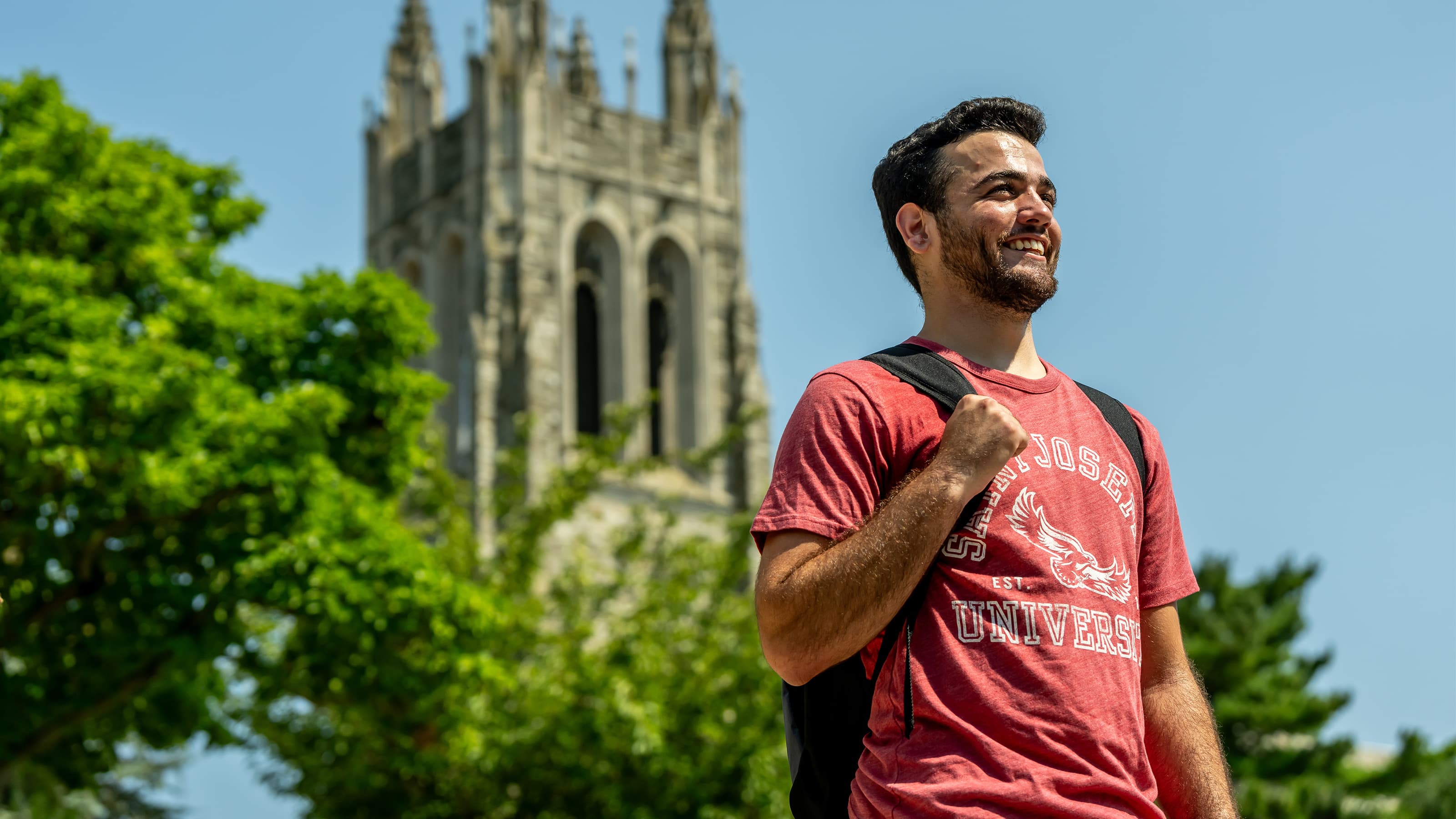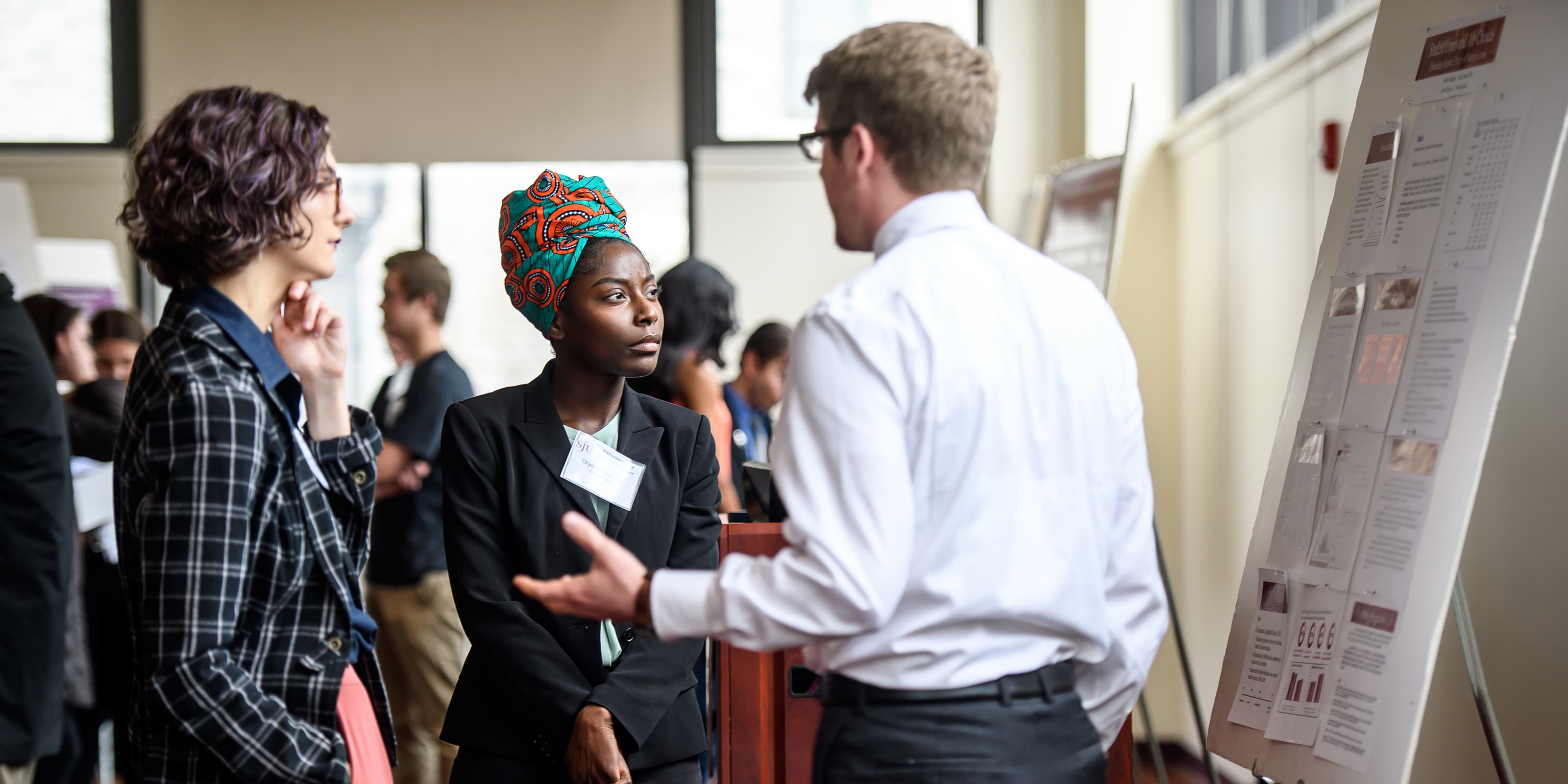SJU Summer Scholars Aim to Forge New Pathways in Education
SJU Summer Scholars aim to produce resources and recommendations that support educators in more effectively meeting the needs of their students.

Most primary and secondary schools are overflowing with a wide range of students — kids who learn and interact in their own ways and come to school each day from unique households. Navigating these differences can be challenging for educators, who are tasked with meeting each student where they are to effectively move them through a curriculum and ensure they are developing collaborative relationships with their peers.
How can one teacher support so many different kinds of children moving through their school day at the same pace all while using the same resources?
This is where Saint Joseph’s University Summer Scholars think they can make a difference.
Three of the 2021 Summer Scholars are determined for to produce recommendations and resources for educators that will support them in meeting the needs of their individual students
MENTORING AND LITERACY INSTRUCTION FOR YOUTH IN THE SCHOOL-TO-PRISON PIPELINE
Jaulie Cantave ’22 | Secondary Education | School of Health Studies and Education
There are an abundance of studies that examine the prevalence of racial disparities in school-based discipline. In fact, many Black and brown students who commit minor infractions like calling out in class or being late, are more susceptible than their white peers to extreme disciplinary measures like suspension, expulsion or being taken into police custody.
As part of her Summer Scholars research, Jaulie Cantave ’22, currently a secondary education major focusing on English, is working with a group of probated students in order to develop recommended interventions for students in the school-to-prison pipeline.
“The school-to-prison pipeline is essentially a sociological phenomenon,” notes Cantave. “These students are oftentimes exhibiting the same behaviors as their more affluent, white peers at school. But unlike their white peers, they are being pushed out of their normal school environments and required by law to participate in supplemental services.”
That’s where Cantave comes in.
At The Academy in Norristown — an alternative academic day-program for teens who have demonstrated disruptive behavior in traditional and alternative educational placements — she provides one-on-one literacy tutoring to a small cohort of teenagers who are mandated by law to be there. As Cantave works with these teens, she is taking notes on the efficacy of the methods and tactics she utilizes to connect and engage these students in learning in order to compile a guide on effectively teaching them. Ultimately, Cantave aims to implement interventions that teachers can use, which will mitigate students’ matriculation at prison.
The horrifying thing about this country’s prison industrial complex is that once you’re in it, you never get out.
Jaulie Cantave '22
“The horrifying thing about this country’s prison industrial complex is that once you’re in it, you never get out,” Cantave asserts. “These are teenagers. They all feel immune to consequences and their brains aren’t fully developed. Once they’ve been probated, anything that happens to them will land them in jail — being in the wrong place at the wrong time, small, stupid decisions. It’ll follow them for the rest of their lives.”
Cantave insists these kids deserve the same grace shown to their white peers. Why can’t Black and brown students get second chances, too? One of the major catalysts for acting out in class, says Cantave, is how the traditional school system hasn’t been designed to properly engage its students.
“I would argue that any student is more engaged through an experiential curriculum,” Cantave notes. “We shouldn’t be asking these kids to memorize facts and take tests and that’s the end of their school day. They need to be hands-on, learning by doing. Research shows that is the best way.”
Another large factor in de-motivating students is seeing the hopelessness that surrounds them.
“Their school facilities are crumbling apart, their textbooks are disintegrating. They can see how deflated and overworked their teachers are,” she says. “How are they supposed to feel valued when these are their resources?”
At the end of the summer, Cantave will publish guidelines and recommendations for educators who work with this population of students that will help teachers better engage them in learning, leaving behind the traditional method of incurring disciplinary action.
Cantave hopes this will ebb the flow of probated students into the prison industrial complex and forever change the educational system’s approach to dealing with behavioral issues in Black and brown students.
DIVERSITY IN THE ENGLISH LANGUAGE ARTS CURRICULUM
Shelby Wilson ’24 | English, Linguistics | School of Health Studies and Education
Representation matters. Especially in a child’s formative years when they are discovering who they are and where they belong in the world. Oftentimes, this can be unusually difficult for children in the United States — English curricula are heavily reliant on white, male, Eurocentric authors. This can make children of different races, ethnicities and cultural backgrounds feel left out.
That’s what Shelby Wilson ’24, who is currently double-majoring in English and linguistics at Saint Joseph’s, hopes to address with her Summer Scholars project. Wilson will be introducing literature that is not typically included on a junior and senior literature curriculum — from writers like Nikki Giovanni, James Baldwin and Maya Angelou — and studying the impact these authors have on student engagement.
In order to most accurately compare and contrast, Wilson will be interviewing her peers on their remembered reactions to required reading in high school and whether or not they felt reflected in the language arts curriculum in their own high schools.
“I myself remember touching on some authors beyond white males,” remembers Wilson. “But most of our reading centered on Shakespeare or Wordsworth.”
Most high school language arts curricula rely heavily on the influential and often white western literary canon — the books and texts that have long been revered in public education as representing the depth and breadth of the United States’ national common experience. All high school students are studying these texts. But what was once defined as “common” — middle class, white, cisgender people — is no longer the reality in the U.S.
What was once defined as “common” — middle class, white, cisgender people — is no longer the reality in the U.S.
Studies show that the media consumed by children shapes what they imagine to be possible for people who look like them, live where they live, or come from where they came from. Simply put, kids determine what they can be based on the examples around them.
In this way, Wilson considers this project a call to action.
“Representation in the English curriculum will not only benefit students of color in how they see and value themselves,” Wilson notes. “This is going to open up white students to different cultures and experiences as well and become accustomed to the idea that people who don’t look like them can take on these roles.”
Though early on in her time at Saint Joseph’s, this project is one example of how Wilson’s professional plans have already changed.
“Originally, I wanted to be a teacher,” she says. “But now I think I’m more interested in curricular design. I want to study the effects this kind of diversity has in classrooms, show it to other educators and say, ‘This might have a better impact on your students, give it a try.’”
I want to study the effects this kind of diversity has in classrooms, show it to other educators and say, ‘This might have a better impact on your students, give it a try.’
Shelby Wilson '24
SOCIAL-EMOTIONAL ASSISTIVE TECHNOLOGY FOR NEURODIVERSE PRESCHOOLERS: A GUIDE FOR EARLY CHILDHOOD EDUCATORS
Deanna Struss ’23 | Autism Behavioral Studies | School of Health Studies and Education
The ability to understand and express human emotions begins developing at birth. By preschool, most toddlers have begun to grasp the concept of using words to express feelings and will continue building empathy and other skills to manage their emotions and respond to the feelings of others throughout childhood.
Neurodiverse children, however, can sometimes find it difficult to recognize emotions in themselves or others. They tend to be slower to develop emotional responses, which means, unlike their neurotypical peers, they often enter preschool without understanding the facial cues or body language that goes along with different feelings. Because of this, preschoolers diagnosed with autism generally benefit from assistive technology being implemented in their classrooms.
“Assistive technology can be as simple as a student utilizing a pencil grip,” says Samantha Riggleman, Ph.D BCBA, assistant professor of special education in Saint Joseph’s School of Health Studies and Education. “Anything removing barriers to that child’s development would be considered assistive technology.”
Riggleman will be advising Deanna Struss ’23, currently an autism behavioral studies major, in her Summer Scholars research to inform early childhood educators about assistive technologies that encourage social-emotional development in children on the autism spectrum.
If young children with exceptionalities don’t learn social-emotional skills like sharing and interacting in preschool, they really continue to struggle as they move through their K-12 experience.
Deanna Struss '23
“These foundational years are really important for children,” says Struss. “If young children with exceptionalities don’t learn social-emotional skills like sharing and interacting in preschool, they really continue to struggle as they move through their K-12 experience.”
For children with autism, who generally have difficulty connecting with their peers, assistive technology might include a picture card map of how to make friends or a communication device they can use to engage with their peers.
To start, Struss will be sending out a survey to all early childhood educators across the United States to get an idea of how they might be struggling with resources and what they know about assistive technology.
Once Struss and Riggleman feel they have gathered enough information from the survey group, Struss will compile data from a preschool cohort with exceptionalities in the Gloucester City School District.
“I plan to implement different assistive technologies within the classroom and videotape its impact on the cohort,” Struss explains. “Then, we’ll use that data to inform the learning modules we compile in Google Classroom.”
Those Google classroom modules will then be shared back with the original, national survey group of early childhood educators.
“I think once these teachers know more about different assistive technologies for this group, they’ll have an easier time requesting and implementing it with their own students,” says Struss.
“What’s really unique about this project is its social-emotional angle,” notes Riggleman. “There’s tons of research about assistive technology and how it supports students but I think focusing on this specific group and using assistive technologies in their social-emotional development is something that hasn’t been touched on yet.”
Read more about our 2021 Summer Scholars:
- History Major Investigates the Convenience of Conspiracy Throughout the Pandemic
- Summer Scholars’ Projects Focus on Diversity, Equity and Inclusion
- Student Examines Cognitive Consequences of Long COVID-19
- Lenora Thomas ’23 Uses Poetry to Express Outcomes of Pandemic Isolation



